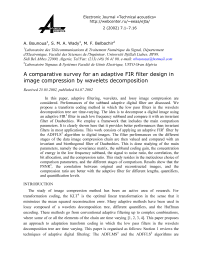A comparative survey for an adaptive fir filter design in image compression by wavelets decomposition
Автор: Bounoua Abdennacer, Wady Sanaa Mohamed Atta, Bel Bachir Mohamed Faouzi
Журнал: Техническая акустика @ejta
Статья в выпуске: т.2, 2002 года.
Бесплатный доступ
In this paper, adaptive filtering, wavelets, and lossy image compression are considered. Performances of the subband adaptive digital filter are discussed. We propose a transform coding method in which the low pass filters in the wavelets decomposition tree are time-varying. The idea is to decompose a digital image using an adaptive FIR (Finite Impulse Response) filter in each low frequency subband and compare it with an invariant filter of Daubechies. We employ a framework that includes the main comparison parameters. It is clearly shown here that it provides better performances than invariant filters in most applications. This work consists of applying an adaptive FIR filter by the ADFFLS (Adaptive Digital Filter with Fast Least Square) algorithm to digital images. The filter performances on the different stages of the data image compression chain are then valued and compared with an invariant and biorthogonal filter of Daubechies. This is done studying of the main parameters, namely the covariance matrix, the subband coding gain, the concentration of energy in the low frequency subband, the signal to noise ratio, the correlation, the bit allocation, and the compression ratio. This study resides in the meticulous choice of comparison parameters, and the different stages of comparison. Results show that the PSNR (Pic Signal Noise Ratio), the correlation between original and reconstructed images, and the compression ratio are better with the adaptive filter for different lengths, quantifiers, and quantification levels.
Короткий адрес: https://sciup.org/14316208
IDR: 14316208


